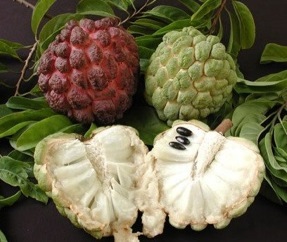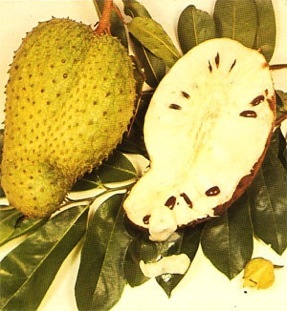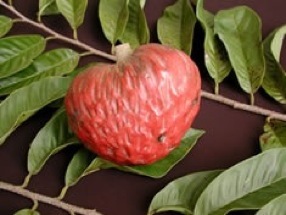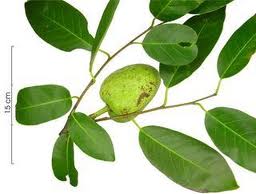The Annonas Four: Sugar, Sour, Custard, Pond
Many species and a few family of plants sit on the cusp of edible/non-edible, among them the Annonas, tropicals which run from delicious to medicinal, but edible. The pulp ranges from sweet with the Sugar Apple or Sweet Soursop, top right, to the ether-
smelling barely tolerable Pond Apple, on bottom right. In between is the Soursop, second from the top, and Custard Apple, next to the bottom. The seeds of all of them are NOT edible. Do not eat them. Also keep your fingers away from your eyes after handing the seeds. Wash your hands first. All Annona are found in Florida into the tropics though their ranges vary.
The Sugar Apple, Annona squamosa (ahn-NOE-nah skwa-MO-suh) is native to the topics. It’s a tree to 20 feet and slender with a round head. Its leaves are evergreen and narrow, up to about four inches long, dull. The flowers are greenish yellow on short stems, three or four in a cluster. The large fruit — up 4.5 inches across — is found in summer. It has a thick rind and is composed of segments which separate when the fruit is ripe. It can range when ripe form yellow to red. The pulp is in segments as well, creamy, sweet, seeds are bean-like. Seeds are not edible. Pulp can be eaten as is or made in to jelly.
Annona muricata (ahn-NOE-nah mur-ee-KAY-tuh) the Soursop, like its cousin, is a tree to 20
feet, slender, has nearly evergreen leaves to four inches. They are dark green, glossy, pungently aromatic. The flowers are whitish, fleshy, on short stems, fruit can be 10 inches long, six inches wide, often an irregular long heart shape with the tip often curling. It is covered with soft spines, flesh is white, cottony, very juicy, subacid to acid, aromatic, seeds black, bean-like. Strained pulp is excellent mixed with milk and sugar as a cold drink and it makes great ice cream. Seeds are not edible. Fruits continuously, found in protected peninsula Florida and the Keys.
The Custard Apple, Annona reticulata (ahn-NOE-nah reh-tick-yoo-LAY-tuh) is a larger tree than the two above, to 25 feet. It is a spreading tree, loses its lance-shaped 7-inch leaves seasonally. The
Custard Apple’s flowers are greenish or yellowish with purple markings. The fruit is conical or heart shaped, up to six inches long. It ranges from yellow to bright red. The pulp is creamy, custard-like, sometimes grainy, sweet. Seeds are like brown beans. Seeds not edible. Able to withstand cold better than the two above it is often found around old South Florida homesteads.
I did not save the best for last. The Pond Apple, Alligator Apple, Annona glabra (ahn-NOE-nah-GLAY-brah.). A large tree, much larger than all those above, to 45 feet. Leaves evergreen, often oval, with pointed tip and glossy. Flowers up to one inch across, whitish or greenish with dark red markings. Fruits nearly all year, conical to five inches long, smooth, rich yellow skin, pulp salmon-yellow in dry segments. Musky, subacid, resinous flavor, not desirable. Some fruit reach edible quality. Seeds NOT edible. Boiling the fruit makes it a bit more palatable. Can be made into a jelly. The tree prefers swamps. Leaves and seeds are insecticidal. Leaves in hens’ nests kills lice on hens. Its seeds can be used to poison fish. If you handle the seeds do NOT touch your eyes until you have washed your hands. Seed power has caused blindness.
Annona is from the Taino word for the tree. Squamosa means scaly, muricata is roughened, reticulata means netted, and glabra smooth or hairless.
HERB BLURB
Annona glabra’s claim to fame is not culinary but medicinal. Seeds, bark and leaves contain many chemicals including acetogenins, apomorphnes alkaloids, cyclopepties, diterpenoids, phenylpropanoid, reticuline and methyl-lacto-daphnine. In large doses most of these are considered poisons. That said test have shown these chemical inhibit tumor growth. Acetogenins prevent oxygen uptake, apomorphine will make you throw up. Pond Apple syrup has been used to treat lung and chest problems, abdominal cramps, colic, diarrhea and dysentery. A tea has been used to kill worms internally, and to treat rheumatism. A fruit rind decoction has been used to treat pulmonary problems. Leaves and flowers boiled together have been used to treat liver trouble, particularly jaundice. However, there is some evidence that tea from the tree can cause symptoms of Parkinson’s Disease.







Thank you for your definitive information on Annona glabra. It helps to know exactly WHAT I have in my back yard. However, now armed with your information, all of the things I imagined doing with the fruit (cooking, eating fresh, making jelly, making wine) seem inadvisable. Do you have any specific suggestions. Each year this time I get more and more fruit. Thanks. mjh
Hi all
Can I also just add to the infamy of A. glabra and say that it is a Weed of National Significance (WoNS) here in Australia (ie recognised nationally for its’ current and potential impact) and is effectively banned for sale and distribution. However, A. glabra is still legally used as grafting root stock for other edible Annona species (eg A. atemoya – custard apple).
Many thanks
Pete
We in the Maldives love the fruit. We use a muslin cloth to squeeze the juice out of the ripe fruit, Take note that the fruit mostly ripens after falling off the tree or left for a day after picking. Take caution, the seeds and only the seeds are poisonous. They have to be removed taking care not to leave any behind especially if you are to use a juicer . The flesh may also be eaten as it is or with some sugar or honey.
Traditionally, the seeds were ground and used as a shampoo to treat head lice (not a common problem now)
When I was in Egypt I used to love to eat the green one in the upper right of the picture.The skin got really soft and the inside was like pudding, I couldn’t get enough of the stuff. It looks like it’s the same thing.
I’ve used the leaves of the Soursop successfully to relax the nerves and help promote a good night’s sleep. I learned about it from herbalists here on the island of St. Croix. It has a very mild taste and is a pleasant, relaxing tea.
I live in the Bahamas where custard apple is enjoyed by all. My mother is originally from an area near Taino Beach in Grand Bahama, now a tourist attraction but once a pond of custard apple which is probably where it got it’s name from. She taught us very early in life how to make a delicious dessert of the custard apple. We take off the thin layer of skin and discard it then squash the pulp with a potato masher add sweet milk (condensed) or cream and sugar. Makes for a delicious treat, simply spit out the seeds if any are left. I never knew the seeds were poisonous but they are so big you would not want to chew or swallow them.
I’ve read that custard apple leaf juice kills lice. It has a heavy requirement for potassium (K), and needs heavy mulching to keep roots cool during hot weather and to conserve moisture. Prune September in the Southern Hemisphere (our spring). Feed and mulch at this time too, or feed and mulch during winter (that seems to be our new “wet season”. )